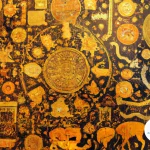Welcome to the fascinating world of astrology and its influence on our romantic relationships. Have you ever wondered why some couples seem to naturally harmonize while others constantly clash? The answer may lie in the planetary aspects at the time of their birth. Planetary aspects refer to the angles formed between two celestial bodies, such as the Sun, Moon, Venus, Mars, and Mercury. These aspects can reveal valuable insights into the dynamics of a relationship, shedding light on compatibility, communication styles, and even the potential challenges that may arise. In this article, we will explore the basics of planetary aspects, how they affect relationships, and offer practical advice on how to navigate and harness their power for a harmonious and fulfilling partnership. So, let’s embark on this cosmic journey together and discover the hidden influence of planetary aspects in our love lives.
The Basics of Planetary Aspects

Planetary aspects are the angles formed between different celestial bodies in astrology. These aspects provide valuable information about the relationship and interaction between these celestial bodies. For example, when two planets are in close proximity or form a specific angle to each other, they create a planetary aspect. Some common aspects include conjunctions (when two planets are in the same sign or degree), oppositions (when two planets are directly across from each other), trines (when two planets are approximately 120 degrees apart), and squares (when two planets are approximately 90 degrees apart). These aspects can have varying influences on a person’s personality and relationships.
In romantic relationships, certain planetary aspects play a significant role in shaping the dynamics between two individuals. For instance, the Sun-Moon aspect represents the interaction between a person’s core identity (Sun) and their emotional needs (Moon), highlighting compatibility and potential challenges in expressing emotions. Another essential aspect is the Venus-Mars aspect, which represents the balance between love (Venus) and desire and sexuality (Mars). This aspect can influence the level of passion and harmony within a relationship. Additionally, the Mercury-Neptune aspect reflects communication styles and the potential for spiritual or imaginative connections between partners.
Planetary aspects have a profound influence on romantic relationships. They can either enhance or challenge the connection between partners, depending on the specific aspects involved. Harmonious aspects, such as trines and sextiles, promote ease, understanding, and compatibility. They help the couple communicate effectively, understand each other’s needs, and find common ground. On the other hand, challenging aspects, like squares and oppositions, may create tension, conflicts, and misunderstandings between partners. These aspects require more effort and understanding to overcome the obstacles they present. By analyzing the planetary aspects in a relationship, astrologers can gain insights into the strengths and weaknesses of the partnership, as well as potential areas of growth and development.
By understanding the fundamentals of planetary aspects, we can delve deeper into the intricacies of romantic relationships and gain a better understanding of the influences that shape our connections with others. Whether you seek to find harmony in your existing relationship or are looking for clarity in a new partnership, exploring the planetary aspects can provide valuable insights to guide you on your journey towards love and happiness.
1. What are Planetary Aspects?
To understand what planetary aspects are, we need to delve into the realm of astrology. Planetary aspects refer to the angles formed between celestial bodies, such as the Sun, Moon, planets, and other significant points in an astrological chart. These aspects hold immense significance as they reveal the relationship and interaction between these celestial bodies, providing insights into various aspects of our lives, including romantic relationships.
Planetary aspects can be classified into different categories based on the angular separation and geometry between the celestial bodies involved. Some of the most common aspects include:
1. Conjunctions: This occurs when two planets are in close proximity, typically within a 10-degree orb. Conjunctions signify an intense blending of energies, where the traits and influences of the two planets involved merge together. For example, a Sun-Mercury conjunction may indicate a strong connection between one’s core identity (Sun) and communication style (Mercury).
2. Oppositions: Oppositions occur when two planets are directly across from each other, forming a 180-degree angle. This aspect represents a polarity and potential tension between the energies of the planets involved. For instance, a Mars-Venus opposition might suggest a push and pull between passion (Mars) and love (Venus) in a relationship.
3. Trines: Trines occur when two planets are approximately 120 degrees apart, forming a harmonious angle. Trines represent ease, flow, and harmony between the planets involved. They can indicate natural talents, compatibility, and positive interactions. For example, a Moon-Jupiter trine may signify emotional well-being (Moon) and abundance (Jupiter).
4. Squares: Squares occur when two planets are approximately 90 degrees apart, forming a challenging angle. Squares represent tension, obstacles, and conflicts that need to be overcome. This aspect often highlights areas of growth and development within a relationship. For instance, a Sun-Saturn square might suggest a struggle between personal expression (Sun) and responsibilities and limitations (Saturn).
These are just a few examples of the planetary aspects that astrologers analyze to gain insights into different areas of life, including romantic relationships. By examining these aspects in an individual’s birth chart or in the synastry between two people, astrologers can provide valuable guidance, helping individuals navigate the complexities and dynamics of their relationships.
Understanding planetary aspects can offer profound insights into the strengths, challenges, and potential for growth within a romantic partnership. It helps individuals understand the energetic dynamics between themselves and their partners and provides a roadmap for maximizing compatibility and addressing areas of potential conflict. By utilizing the knowledge of planetary aspects, individuals can gain a deeper understanding of themselves and their partners, fostering healthier and more fulfilling romantic relationships.
So, whether you are seeking clarity in an existing relationship or embarking on a new romantic journey, exploring the intricate dance of planetary aspects can enhance your understanding and pave the way for a more harmonious and fulfilling connection.
Read more: Astrological Tips for Goal Planning and Execution
2. Common Planetary Aspects in Relationships
In romantic relationships, there are several common planetary aspects that hold significance in astrology. These aspects provide valuable insights into the dynamics and compatibility between two individuals. Here are some of the most frequently encountered planetary aspects in relationships:
1. Conjunctions: A conjunction occurs when two planets are in close proximity or occupy the same sign or degree. This aspect signifies a merging of energies and traits between the two planets involved. For example, a Sun-Moon conjunction indicates a strong emotional bond and compatibility between partners.
2. Oppositions: An opposition occurs when two planets are directly across from each other, approximately 180 degrees apart. This aspect represents a balance of energies but can also lead to conflicts and challenges. For instance, a Mars-Venus opposition may indicate a potential clash between desires and romantic expression in a relationship.
3. Trines: A trine occurs when two planets are approximately 120 degrees apart. This aspect signifies harmony, ease, and flow between the planets involved. A Venus-Jupiter trine, for example, indicates a natural affinity for love, joy, and abundance in a relationship.
4. Squares: A square occurs when two planets are approximately 90 degrees apart. This aspect represents tension, obstacles, and conflicts. It often requires effort and growth to overcome the challenges it presents. A Mercury-Neptune square may suggest difficulties in expressing and understanding each other’s thoughts and emotions.
Understanding these common planetary aspects can provide a deeper understanding of the dynamics within a romantic relationship. Combined with the analysis of individual birth charts, astrologers can paint a more detailed picture of compatibility and potential challenges between partners. By knowing the planetary aspects at play, individuals can navigate their relationships with greater awareness and make conscious choices to improve harmony and understanding.
Whether you are exploring a new relationship or seeking to deepen the connection in an existing one, recognizing and understanding the common planetary aspects can offer valuable guidance and insights. Embracing the complexities of these aspects allows individuals to nurture strong and lasting relationships that are built on a foundation of compatibility and understanding.
3. How Planetary Aspects Affect Relationships
The influence of planetary aspects on relationships is multifaceted and can significantly impact the dynamics between two individuals. Various planetary aspects affect relationships in different ways, shaping compatibility, communication, and emotional expression. For instance, the Sun-Moon aspect is crucial in understanding the emotional needs and core identity of each partner. When the Sun and Moon are in harmony, there is a natural alignment of emotional needs and self-expression. However, a challenging Sun-Moon aspect can create emotional imbalances, where one partner may feel misunderstood or neglected while the other struggles to meet their emotional needs.
The Venus-Mars aspect, on the other hand, plays a significant role in a couple’s romantic and sexual compatibility. A harmonious Venus-Mars aspect fosters passion, attraction, and a mutual understanding of each other’s desires and preferences. Couples with challenging Venus-Mars aspects may experience conflicts in their romantic and sexual lives, such as differences in levels of desire or conflicting approaches to intimacy.
Another important aspect to consider is the Mercury-Neptune aspect, which affects communication within a relationship. A harmonious Mercury-Neptune aspect promotes open and empathetic communication, allowing partners to express their thoughts and emotions with ease. However, challenging Mercury-Neptune aspects can lead to misunderstandings and miscommunications, as partners may struggle to understand each other’s perspectives and intentions.
It’s crucial to note that not all planetary aspects have negative effects on relationships. In fact, some challenging aspects can serve as catalysts for growth and development. They provide opportunities for couples to work through their differences, learn effective communication strategies, and deepen their understanding of one another. By acknowledging and addressing these challenges, couples can strengthen their bond and create a more solid foundation for their relationship.
Each relationship is unique, and the impact of planetary aspects will vary from couple to couple. It is essential to interpret these aspects within the context of an individual’s birth chart to gain a comprehensive understanding of their influence. Professional astrologers can provide valuable insights into how specific planetary aspects affect a relationship, guiding couples towards better understanding, compromise, and mutual growth.
Understanding the influence of planetary aspects on relationships empowers individuals to navigate the challenges and opportunities that arise in their romantic endeavors. By recognizing the significance of these celestial influences, couples can work together to cultivate a strong and harmonious bond. Whether it’s seeking compatibility in a new relationship or working towards improving an existing one, exploring the effects of planetary aspects allows individuals to create fulfilling and balanced connections with their partners.
Interpreting Planetary Aspects
Interpreting planetary aspects in romantic relationships requires a deep understanding of each planet’s symbolism and how they interact with one another. One essential aspect to consider is the Sun-Moon aspect, which represents the connection between a person’s core identity (Sun) and their emotional needs (Moon). A harmonious Sun-Moon aspect, such as a trine or conjunction, indicates that the individual’s emotional needs align with their authentic self, promoting a healthy self-expression within the relationship. Conversely, a challenging aspect, such as a square or opposition, may create inner conflicts and difficulties in balancing personal desires with emotional needs.
Another significant aspect to consider is the Venus-Mars aspect, which influences the balance between love (Venus) and desire and sexuality (Mars). A harmonious aspect between Venus and Mars, such as a trine, fosters a passionate and harmonious connection, where love and desire are well-balanced. However, challenging aspects, like a square or opposition, may lead to conflicts between partners’ romantic desires and sexual needs. Communication and understanding are crucial in navigating these aspects, as they can ignite powerful attractions or create tensions within a relationship.
Mercury-Neptune aspects, on the other hand, focus on communication styles and spiritual or imaginative connections. A harmonious aspect between Mercury and Neptune, such as a trine, enhances the couple’s ability to communicate with empathy, compassion, and intuition. This aspect allows for a deep understanding of one another’s thoughts, dreams, and desires. In contrast, challenging aspects, such as squares, may create confusion in communication or unrealistic expectations. Open and honest dialogue, accompanied by active listening, is essential in navigating the potential challenges brought by Mercury-Neptune aspects.
To interpret these planetary aspects effectively, it is essential to consider the sign and house placement of each planet involved in the aspect. This provides a more nuanced understanding of how the aspect manifests in the individual’s personality and relationship dynamics. Consulting with a professional astrologer can offer valuable insight and guidance in comprehending the complexities of planetary aspects and their impact on romantic relationships.
Understanding and interpreting planetary aspects allows us to gain a deeper understanding of the dynamics within a romantic relationship. By recognizing the strengths and challenges highlighted by these aspects, couples can cultivate effective communication, navigate conflicts, and foster a harmonious and fulfilling connection. Exploring the planetary aspects provides a fascinating lens through which we can better comprehend and appreciate the nuances of love and astrology’s influence on our romantic lives.
1. Sun-Moon Aspects
Sun-Moon aspects in astrology provide valuable insights into the interaction between a person’s core identity (Sun) and their emotional needs (Moon) within a romantic relationship. These aspects shed light on the compatibility and potential challenges that may arise between partners. There are several types of Sun-Moon aspects, each with its own unique influence.
1. Sun Conjunct Moon: This aspect occurs when the Sun and Moon are in the same sign or degree. It represents a harmonious blend of the individual’s identity and emotional needs. Partners with this aspect share a strong connection and understanding of each other’s emotions. They are likely to have similar values and life goals, making it easier to navigate the ups and downs of life together.
2. Sun Opposition Moon: In this aspect, the Sun and Moon are directly across from each other in the zodiac. This creates tension and polarity within the relationship. Partners with this aspect may find themselves grappling with conflicting desires and needs. It is important for them to find a balance between their individual identities and emotional needs while considering the needs of their partner.
3. Sun Trine Moon: This aspect occurs when the Sun and Moon are approximately 120 degrees apart. It signifies harmony, support, and a natural understanding between partners. They are likely to have compatible emotional needs and will be supportive of each other’s goals and aspirations. This aspect fosters a sense of emotional security and stability within the relationship.
4. Sun Square Moon: The Sun and Moon are approximately 90 degrees apart in this aspect. It represents tension and challenges in reconciling individual identities with emotional needs. Partners with this aspect may experience power struggles and difficulties in emotional expression. Open and honest communication is crucial to overcome the obstacles presented by this aspect.
Interpreting Sun-Moon aspects can provide valuable insight into the emotional dynamics of a romantic relationship. It helps partners understand each other’s needs and work towards creating a harmonious balance between their individual identities and emotional fulfillment. By acknowledging and embracing the strengths and challenges of their Sun-Moon aspects, couples can navigate the complexities of their relationship with greater understanding and empathy.
To further enhance your understanding of astrology, you may also be interested in exploring how to find the right diet based on your zodiac sign. Understanding the astrological influences on your physical health and well-being can offer more holistic insight into your overall lifestyle choices.
2. Venus-Mars Aspects
When it comes to romantic relationships, Venus-Mars aspects are of great significance. Venus represents love, beauty, and harmony, while Mars symbolizes desire, passion, and sexual energy. The interaction between these two planets can have a profound impact on the dynamics of a relationship.
Conjunction: A Venus-Mars conjunction occurs when these two planets are in the same sign or degree. This aspect intensifies the blending of love and desire, creating a strong attraction and a sense of passion between partners. It signifies a relationship fueled by both physical and emotional connection. These individuals often have a magnetic allure and a deep, natural compatibility, making them incredibly passionate and affectionate with each other.
Square: A Venus-Mars square happens when these two planets form a 90-degree angle to each other. This aspect can create tension and conflicting desires within a relationship. Individuals with this aspect may struggle to balance their need for love and partnership (Venus) with their assertiveness and desire for independence (Mars). This could lead to power struggles or unbalanced dynamics within the relationship. However, if both partners are willing to work on finding a middle ground and compromise, this aspect can also bring excitement and a spark of challenge that keeps the relationship dynamic and passionate.
Opposition: Venus-Mars opposition occurs when these two planets are directly across from each other. This aspect represents a pull between love and desire, creating a sense of magnetic attraction and potential conflicts. Partners with this aspect may experience a push and pull dynamic in their relationship, oscillating between intense passion and moments of discord. It is important for these individuals to find a balance and establish open communication to navigate any potential challenges or differences in needs.
Understanding the Venus-Mars aspects in a relationship can help partners navigate their desires and find a healthy balance between love, harmony, and passion. By acknowledging each other’s needs and communicating openly, couples can harness the power of these aspects to cultivate a strong and fulfilling bond. Additionally, seeking professional astrological guidance and exploring the influence of other planetary aspects can provide a comprehensive understanding of how these dynamics interact and shape the relationship. So, embrace the exploration of Venus-Mars aspects and discover the keys to unlocking a harmonious and passionate connection with your partner.
3. Mercury-Neptune Aspects
Mercury-Neptune aspects in a romantic relationship bring an element of depth, sensitivity, and imagination to the dynamics between partners. Mercury, the planet of communication and intellect, when influenced by dreamy Neptune, gives rise to a connection that transcends ordinary conversation. This aspect fosters a shared understanding of emotions and a telepathic connection, as if partners can communicate without words.
Those with harmonious Mercury-Neptune aspects often experience a deep sense of empathy and compassion for each other. They intuitively understand each other’s thoughts and feelings, even when they are left unspoken. This aspect enhances emotional bonding and creates a safe space for vulnerability and emotional expression. Partners may find themselves finishing each other’s sentences or having moments of synchronicity, as their minds align and blend into a harmonious whole.
However, it’s important to note that Mercury-Neptune aspects can also present challenges in communication. The ethereal nature of Neptune can sometimes lead to confusion, misinterpretations, or even deception if the energies of this aspect are not balanced. Partners might idealize each other or have unrealistic expectations, which can lead to disappointment if the reality doesn’t meet their fantasies. It’s crucial for individuals with this aspect to maintain open and honest communication, grounding their dreams and aspirations in reality.
To navigate Mercury-Neptune aspects in a relationship, it’s essential to cultivate clear and transparent communication. Partners should prioritize active listening and reiterate their thoughts and feelings to ensure mutual understanding. Honesty and authenticity are key in preventing misunderstandings and preserving trust between partners. Setting healthy boundaries is also vital to avoid becoming too absorbed in each other’s emotions or losing individuality within the relationship.
Seeking professional astrological guidance can be immensely helpful in understanding the complexities of Mercury-Neptune aspects in a relationship. An experienced astrologer can provide personalized insights and advice tailored to the specific dynamics between partners. They can shed light on the potential pitfalls of this aspect and offer strategies for harnessing its positive qualities while overcoming any challenges that may arise.
Mercury-Neptune aspects bring a touch of magic and sensitivity to romantic relationships. They enhance emotional connection, empathy, and deep understanding. However, partners must also be mindful of the potential pitfalls, such as illusions or miscommunications. By fostering clear communication, grounded expectations, and seeking guidance when needed, couples can navigate and embrace the beautiful and transformative energies that Mercury-Neptune aspects bring to their relationship.
Navigating Planetary Aspects for a Harmonious Relationship

Navigating the complexities of planetary aspects in a romantic relationship is essential for fostering harmony and growth. Acknowledging and understanding each other’s planetary aspects is the first step in creating a solid foundation. It is crucial to recognize that everyone’s astrological makeup is unique, and understanding how these aspects influence each partner can help cultivate empathy and compassion. By recognizing the strengths and challenges that arise from these aspects, couples can work together towards finding common ground and building a healthy relationship.
Effective communication and compromise are key components in navigating planetary aspects for a harmonious relationship. With open and honest communication, couples can express their needs, concerns, and emotions, fostering understanding and deeper connections. It is important to actively listen to your partner and validate their feelings, even if they may differ from your own. Finding common ground and compromising on differences can help create a balanced and nurturing environment for both individuals.
For couples who find it challenging to navigate their planetary aspects on their own, seeking professional astrological guidance can be beneficial. Astrologers specializing in relationship astrology can provide unique insights and guidance based on the specific planetary aspects present in a couple’s birth charts. They can help identify potential areas of tension and offer strategies to work through challenges. Utilizing their expertise, couples can gain a deeper understanding of themselves and their partner, ultimately leading to a more harmonious and fulfilling relationship.
Remember, the goal of navigating planetary aspects is not to eliminate all challenges but rather to understand and work with them. Each aspect offers an opportunity for growth, self-awareness, and deeper connection. By acknowledging and respecting each other’s unique astrological makeup, practicing effective communication, and seeking professional guidance when necessary, couples can navigate their planetary aspects to create a harmonious and thriving relationship.
Whether you are starting a new relationship or working on an existing one, understanding and navigating planetary aspects can provide valuable insights and tools for creating a loving and fulfilling partnership. Embrace the intricacies of your astrological makeup and use it as a guide to enhance your relationship journey. By working together with the energy of the stars, you can build a strong foundation and navigate the winding paths of love with grace and understanding.
1. Acknowledge and Understand Each Other’s Aspects
One crucial step in navigating the influence of planetary aspects in a romantic relationship is to acknowledge and understand each other’s aspects. This involves recognizing and discussing the specific planetary aspects that exist between you and your partner. Take the time to share your birth charts and consult with an astrologer who can help interpret your unique aspects. By understanding each other’s aspects, you gain insight into your partner’s personality traits, needs, and potential challenges.
To facilitate this process, consider creating a table or list summarizing the planetary aspects in your relationship. Write down the specific aspects that exist, such as Sun-Moon, Venus-Mars, or Mercury-Neptune. Highlight the nature of these aspects, whether they are harmonious or challenging, and describe their potential impact on your relationship dynamics. For example, if there is a challenging square aspect between your Sun and your partner’s Moon, it could indicate potential conflicts in expressing emotions and meeting each other’s needs. On the other hand, if there is a harmonious trine aspect between your Venus and your partner’s Mars, it may suggest a natural flow of love and passion between you.
By acknowledging and understanding each other’s aspects, you cultivate awareness and compassion for the unique qualities and challenges each person brings to the relationship. It allows you to approach differences with empathy and navigate potential conflicts with greater understanding. Understanding your partner’s aspects can also shed light on their communication style, emotional needs, and love language, enabling you to foster deeper connection and intimacy.
Remember, the purpose of acknowledging and understanding each other’s aspects is not to put labels or limitations on your relationship, but rather to gain insight and promote growth and harmony. Embrace the uniqueness of your aspects and use them as a guide to navigate your relationship more consciously and authentically. By doing so, you create a foundation of understanding and open communication, which can significantly contribute to the success and fulfillment of your romantic partnership.
In the next part of our article, we will explore the importance of communication and compromise in navigating the influence of planetary aspects in romantic relationships.
2. Communication and Compromise
Communication and compromise are crucial aspects of navigating relationships influenced by planetary aspects. When dealing with differing perspectives, it is essential to establish open and honest lines of communication. Each partner should express their thoughts, feelings, and needs clearly, ensuring that there is a mutual understanding. Effective communication involves active listening, empathy, and a willingness to see things from the other person’s point of view. This is particularly important when challenging aspects are present, as they can potentially lead to misunderstandings and conflicts. Building strong communication skills can help couples navigate through difficult periods and find resolution.
Compromise is another key component of maintaining a harmonious relationship. Aspects such as squares and oppositions often require partners to find middle ground and make concessions. It is important for both individuals to acknowledge and respect each other’s differences, finding a balance where both parties feel heard and valued. Compromise involves finding creative solutions that meet the needs and desires of both partners, while also respecting the boundaries and values of the relationship. Flexibility and a willingness to adjust one’s perspective or expectations can go a long way in fostering a healthy and thriving partnership.
In relationships influenced by planetary aspects, it is crucial to remember that compromise does not mean sacrificing one’s own needs or authenticity. It is about finding common ground and mutually beneficial solutions. By cultivating effective communication and a spirit of compromise, couples can navigate the challenges posed by planetary aspects and foster a strong and resilient bond.
In the next section, we will explore the option of seeking professional astrological guidance to gain deeper insights into the influence of planetary aspects on romantic relationships. Professional astrologers can provide personalized interpretations and guidance to help couples navigate their unique challenges and harness the powerful energies of the celestial bodies. So, let’s dive into the benefits of seeking professional astrological advice in our journey to understanding planetary aspects in relationships.
3. Seeking Professional Astrological Guidance
Seeking professional astrological guidance can be immensely beneficial when navigating the complexities of planetary aspects in romantic relationships. An experienced astrologer can provide personalized insights and interpretations based on your unique birth charts and the specific planetary aspects present. Here are some reasons why seeking professional guidance is valuable:
1. Comprehensive Analysis: Astrologers have a deep understanding of the intricate dynamics between celestial bodies and how they influence our lives. They can analyze your birth chart, interpret the planetary aspects, and provide a comprehensive analysis of how these aspects impact your romantic relationship.
2. Relationship Compatibility: Astrologers can assess the compatibility between you and your partner by examining the planetary aspects in your birth charts. They can identify potential areas of harmony and areas that may require attention and effort. This insight can help you understand the overall compatibility and dynamics within your relationship.
3. Insightful Guidance: Professional astrologers can provide guidance and advice on how to navigate the challenges presented by challenging aspects. They can offer insights on communication strategies, conflict resolution, and finding common ground based on the specific planetary influences in your relationship.
4. Long-term Relationship Planning: Astrologers can help you identify favorable planetary aspects for long-term planning in your relationship. They can offer insights into auspicious times for important milestones such as marriage, starting a family, or embarking on joint ventures.
When seeking professional astrological guidance, it’s essential to choose a reputable astrologer who specializes in relationships and understands the nuances of planetary aspects. A consultation with an expert can provide you with the clarity and guidance needed to navigate your romantic relationship with awareness and insight.
So, whether you’re looking for validation, guidance, or simply a deeper understanding of the planetary aspects in your romantic relationship, consulting with a professional astrologer can empower you to make informed decisions and foster a harmonious and fulfilling partnership.
Working with Planetary Aspects in Real-Life Relationships
Working with planetary aspects in real-life relationships requires a deep understanding of astrology and a willingness to navigate the complexities that arise. Here are some practical tips for incorporating planetary aspects into your relationship:
1. Acknowledge and Understand Each Other’s Aspects: Take the time to learn about your partner’s planetary aspects and how they influence their personality and behavior. This understanding can provide valuable insights into their needs, communication styles, and potential challenges. It’s essential to approach this process with an open mind and a non-judgmental attitude, as each person’s aspects contribute to their unique qualities and quirks.
2. Communication and Compromise: Effective communication is key to any relationship, but it becomes even more crucial when working with planetary aspects. Be mindful of how your partner’s aspects may impact their communication style, emotional expression, and decision-making. Aim for open, honest, and compassionate conversations, where both partners actively listen and seek to understand each other’s perspectives. Compromise and finding common ground are also essential when dealing with incompatible aspects, as it allows for mutual growth and understanding.
3. Seeking Professional Astrological Guidance: If you find yourself struggling to navigate the complexities of your planetary aspects, seeking professional astrological guidance can provide clarity and guidance. An experienced astrologer can analyze your charts and offer valuable insights into your compatibility, areas of growth, and potential challenges. They can provide personalized advice tailored to your unique planetary aspects, helping you navigate your relationship with greater awareness and harmony.
By actively incorporating these strategies into your relationship, you can harness the power of planetary aspects to cultivate a deeper understanding and stronger connection with your partner. Remember that astrology is a tool that can aid in self-reflection and personal growth, but it should not be the sole determinant of the success or failure of a relationship. Ultimately, it is up to both partners to nurture their connection, embrace their strengths, and work through any challenges that arise.
So, embrace the intricacies of your planetary aspects and let them guide you towards a more fulfilling and harmonious relationship.
1. Case Study: John and Sarah’s Relationship
John and Sarah’s relationship provides an insightful case study on how planetary aspects can influence romantic partnerships. John, born under a Leo Sun, and Sarah, born under an Aquarius Sun, have a Sun-Moon opposition aspect in their birth charts. This aspect reflects a natural tension between their core identities (Sun) and emotional needs (Moon). John’s Leo Sun craves attention, recognition, and warmth, while Sarah’s Aquarius Sun values independence, intellectual stimulation, and a sense of uniqueness. This fundamental difference in their personalities can create challenges regarding emotional expression, as John may seek more affection and validation than Sarah is naturally inclined to provide.
Additionally, their Venus-Mars aspect plays a role in their relationship dynamics. While John’s Venus in Virgo is detail-oriented, practical, and seeks stability in love, Sarah’s Mars in Gemini is more spontaneous, adventurous, and craves variety. This Venus-Mars dynamic can lead to differences in their approach to romance and intimacy. John may desire a structured and predictable relationship, while Sarah may prefer spontaneity and an intellectual connection.
The Mercury-Neptune aspect in their charts influences their communication styles. John’s Mercury in Leo encourages him to express himself passionately and confidently, while Sarah’s Neptune in Sagittarius adds a touch of idealism and spirituality to her communication style. This aspect can result in miscommunication or challenges in understanding each other’s perspectives. John’s direct communication may clash with Sarah’s tendency to be more abstract or elusive in expressing herself.
Despite these planetary aspects presenting challenges, John and Sarah’s relationship is not doomed. Understanding these aspects provides valuable insights into their dynamics, allowing them to navigate their differences consciously. By acknowledging and embracing their individual needs and communication styles, they can work together to bridge the gap and find common ground. It is vital for John and Sarah to communicate openly, expressing their emotional needs and working towards compromise and understanding.
This case study highlights the significance of planetary aspects in relationships. Each couple’s unique combination of aspects creates a distinct energetic signature that influences their interactions and compatibility. By studying and interpreting these aspects, astrologers can offer guidance and insights into the strengths and challenges within a relationship. Ultimately, it is up to the individuals involved to navigate their aspects consciously and work towards a harmonious and fulfilling partnership.
2. Lessons Learned from John and Sarah’s Relationship
Reflecting on John and Sarah’s relationship, we can draw valuable lessons that highlight the influence of planetary aspects in romantic relationships. Despite their initial strong attraction and compatibility, they faced significant challenges due to the square aspect between their Sun signs. John’s Sun was in Aries, while Sarah’s Sun was in Cancer. This aspect created tension and conflicts, as they had differing approaches to expressing their individuality and emotional needs. It became apparent that compromise and understanding were essential for their relationship to thrive.
The first lesson we can learn from John and Sarah’s relationship is the importance of open and effective communication. They realized that they needed to openly express their feelings and needs, even when they differed from one another. By practicing active listening and empathetic communication, they were able to better understand and support each other.
The second lesson is the need for compromise and flexibility. John and Sarah had to find a balance between their fiery and assertive natures (Aries) and their emotional sensitivities (Cancer). They learned that compromise was crucial in order to meet each other’s needs and maintain harmony in their relationship. This required both partners to be willing to adapt and make concessions to create a harmonious middle ground.
Lastly, John and Sarah realized the significance of seeking professional advice and guidance. They consulted an astrologer who provided them with insights into their planetary aspects and how they affected their relationship. This external perspective allowed them to gain a deeper understanding of each other, work through their challenges, and navigate their relationship more effectively.
The lessons learned from John and Sarah’s relationship demonstrate the impact of planetary aspects on romantic relationships. Effective communication, compromise, and seeking professional guidance can help couples overcome challenges and build a stronger connection. Understanding and embracing the influence of planetary aspects can lead to growth, harmony, and a greater sense of fulfillment in romantic relationships. By incorporating these lessons into our own relationships, we can cultivate healthier and more fulfilling connections with our partners.
Conclusion

In conclusion, planetary aspects play a significant role in romantic relationships, offering valuable insights into compatibility, communication styles, and potential challenges. By understanding the basics of planetary aspects, we can navigate our relationships with greater awareness and insight. It is important to acknowledge and understand each other’s aspects, recognizing that everyone brings their unique energies and dynamics to the partnership. Effective communication and compromise are key to fostering a harmonious relationship, allowing for understanding and growth. However, when faced with challenges or seeking deeper understanding, seeking professional astrological guidance can provide clarity and guidance. Remember, no relationship is without its complexities, but by working with the planetary aspects, we can create stronger and more fulfilling connections with our partners. So, embrace the power of planetary aspects, and let the stars guide you on your journey towards love and happiness.
References
- Google [online]. Available at: www.google.com
- Cafe Astrology [online]. Available at: www.cafeastrology.com
- Family and Home Life Predictions
Frequently Asked Questions

1. How do planetary aspects impact romantic relationships?
Planetary aspects can greatly influence romantic relationships by shaping compatibility, communication dynamics, and areas of potential conflict. They reveal insights into how partners interact with one another and navigate challenges.
2. Can planetary aspects determine the success or failure of a relationship?
While planetary aspects provide valuable information, they do not determine the success or failure of a relationship. They offer insights into strengths and challenges, but how partners navigate and work on their relationship plays a significant role in its outcome.
3. Are there specific planetary aspects that indicate a strong emotional connection between partners?
Yes, aspects such as the Sun-Moon conjunction, sextile, or trine can indicate a strong emotional connection between partners. These aspects facilitate understanding, empathy, and emotional harmony.
4. Do challenging planetary aspects always lead to relationship problems?
Challenging planetary aspects, such as squares or oppositions, can create tension in relationships but do not guarantee problems. With awareness and effort, partners can overcome challenges and grow stronger as a couple.
5. Can planetary aspects help explain attraction and chemistry between partners?
Yes, planetary aspects, particularly the Venus-Mars aspect, can shed light on attraction and chemistry in romantic relationships. They reflect the balance between love, desire, and sexuality, contributing to the overall passion and connection between partners.
6. Can partners with incompatible planetary aspects have a successful relationship?
While compatibility is important, partners with incompatible planetary aspects can still have a successful relationship. Open communication, understanding, and a willingness to work on the relationship can overcome the challenges posed by incompatible aspects.
7. How can one use knowledge of planetary aspects to improve their relationship?
By understanding the specific planetary aspects in a relationship, individuals can gain insights into each other’s needs, communication styles, and potential areas of conflict. This awareness allows for better understanding, empathy, and the ability to find common ground.
8. Do planetary aspects remain constant throughout a relationship?
Planetary aspects at the time of birth remain constant throughout a person’s life. However, the transits or current positions of the planets can create new aspects that influence the relationship dynamics at different times.
9. Can planetary aspects change over time?
The planetary aspects at the time of birth remain fixed. However, as the planets continue to move and change positions, new aspects can form, influencing the relationship dynamics over time.
10. Should astrological advice be sought when navigating the challenges posed by planetary aspects?
Seeking astrological advice can be beneficial when navigating the challenges posed by planetary aspects. A professional astrologer can provide guidance, insight, and practical advice on how to work with and optimize the influence of planetary aspects in a relationship.
References
- Aspects of Love and Relationships: Compatibility in Astrology
- What astrology aspects indicate a fated meeting between …
- How do the planets influence your love life? –
Frequently Asked Questions

1. Can planetary aspects predict the success of a romantic relationship?
While planetary aspects can provide insights into the dynamics of a relationship, they cannot definitively predict its success. Relationships are complex and multifaceted, influenced by a variety of factors such as individual personalities, communication, and compatibility.
2. What happens when two people have conflicting planetary aspects?
Conflicting planetary aspects can create tension and challenges in a relationship. These aspects may highlight areas of disagreement or conflicting desires, requiring open communication and a willingness to compromise in order to find harmony.
3. Are certain planetary aspects more favorable for long-term commitment?
There is no one-size-fits-all answer to this question. Different planetary aspects can contribute to different aspects of commitment, such as emotional connection, sexual chemistry, or intellectual compatibility. It ultimately depends on the individuals involved and their unique needs and values.
4. Can planetary aspects change over time within a relationship?
Yes, planetary aspects can change over time as the planets continue to move in their orbits. These shifts can influence the dynamics of a relationship, potentially bringing new challenges or opportunities for growth.
5. Can planetary aspects indicate the potential for a soulmate connection?
While soulmate connections are not solely determined by planetary aspects, certain aspects can suggest a deep and meaningful connection between two individuals. However, it is important to remember that soulmate connections involve more than just astrology and require mutual love, respect, and compatibility.
6. How can planetary aspects impact sexual compatibility in a relationship?
Planetary aspects can play a role in shaping sexual compatibility by highlighting areas of attraction, passion, or dissonance. For example, harmonious Venus-Mars aspects can indicate a strong physical connection, while conflicting aspects may lead to differences in desires or sexual expression.
7. Can challenging planetary aspects be overcome in a relationship?
Challenging planetary aspects can be overcome with awareness, understanding, and communication. Couples can work together to find compromises, seek professional guidance, and nurture their relationship in order to navigate the challenges posed by these aspects.
8. Are there any planetary aspects that indicate a potential for strong emotional connection?
Aspects involving the Moon, such as harmonious Sun-Moon or Moon-Moon aspects, can suggest a strong emotional connection. These aspects may indicate a deep understanding and empathy between partners, fostering a sense of emotional intimacy.
9. How can planetary aspects influence communication patterns in a relationship?
Certain planetary aspects, such as harmonious Mercury-Venus aspects, can promote effective and harmonious communication in a relationship. Conversely, challenging aspects like Mercury-Neptune can lead to miscommunication or confusion. Awareness of these aspects can help partners navigate potential communication difficulties.
10. Can planetary aspects provide guidance in choosing a compatible partner?
Planetary aspects can offer insights into potential compatibility, but it is important to remember that astrology is just one tool in the realm of relationships. It is crucial to consider other factors such as shared values, interests, and emotional connection when choosing a compatible partner.






